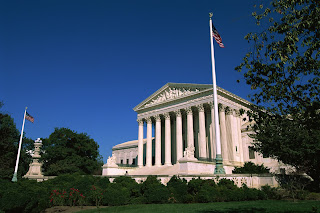I am on the website committee for a lawyer organization that I belong to. The organization is redesigning its website. The membership of the organization is comprised, for the most part, of lawyers who have been practicing a long time. Translated that means they are not in their twenties, and social media is very new and bewildering to them.
This web site committee had a meeting recently to review the rough draft, live website. Prominently displayed up in the right hand corner of the new design were the one-click buttons for
Google+ LinkedIn,
Facebook, and
Twitter. All the committee members liked how the buttons looked. However, things got a bit complicated once the question was asked: "who is going to post the content to the social media pages?"
"Post content?" "What do you mean? "I thought stuff just appeared about us when we put the buttons on our website?" It became very clear in short order that no one on the committee had the foggiest idea what LinkedIn or Facebook or Twitter did. A dialogue ensued by which it was explained that clicking on the social media buttons allowed the visitors to subscribe to, and/or visit the organization's LinkedIn page, or the organization's Facebook page, or the organization's twitter page. However, no one was aware that unless you had someone writing articles, and posting content to each of those pages there would not be anything for the visitor to see on her visit, and nothing to receive through her subscription.
Another very good question that was asked was: "why do we need a Google Plus page if we already have a website?
Here is what you need to know my friends: Goggle+ pages, and LinkedIn accounts, and Facebook pages, and Twitter accounts are nothing more than blank billboards. If you want your message to get out, the first thing you have to do is write your message. Then you have to post your message to your social media page. Then you have to create and post a new message. And then another one. And then another. And so on, and so on. You want a Facebook page or a Goggle Plus page in addition to a website to get your message out to a broader audience. Just like you might have a billboard downtown, and one in the suburbs, or a Yellow Pages ad in the Chicago phone book and a second ad in the Joliet phone book. A website, and a social media sight increase your audience; increase your exposure to search engines, and act as a cross-pollinators for your internet presence. People viewing your website then click over to your LinkedIn page, and people viewing your LinkedIn page then click over to your website, etc., etc.
Nothing comes easy though and social media is no exception. The ultimate goal of social media for lawyers is to draw attention to yourself and your law practice, so that people will hire you to be their lawyer. This happens through people subscribing to your social media site so that your freshly posted content is sent directly to them. It also happens when the search engines perceive that your social media account has been updated with fresh content so that you move up higher in the search engine rankings.
Take a look at this post. It is filled with words, and it has a picture. It took time to write this article. When I clicked on the publish button in my blog software this article was posted on my blog. A summary of the article, along with the picture were simultaneously posted to my Google+ page, my Facebook page, my Twitter page, and my LinkedIn page. The people who are subscribers to this blog automatically received a copy of this article in their email inbox. Because there are a bunch of words in this post, and a picture, it will draw the attention of Google and Yahoo. When someone does a Google search of, for example, "social media for lawyers," all of those word are in this article, Google will do the math, and it could then very will post a link to this article in response to that search. In a few days I will generate a report to see how many people read this article. It will probably be somewhere in the neighborhood of 150 to 200 people. 200 people might read this article! That means 200 people will be thinking about me because I am the author of this article. 200 people will read the name John Harding. 200 people will read the name Harding & Associates Family Law. 200 people will have the opportunity to click on the link to my website that appears at the bottom of this story. Guess what? About 75 to 100 people actually will click on that link to my website. There they will read all about me and my family law practice. That increased traffic on my website is also something that stimulates the search engines and helps my website pop up in Google when some searches for a divorce lawyer!
For the more senior set or readers out there, let me draw an analogy for you. 75 to 100 people will have opened up the Yellow Pages and studied my ad, and thought about hiring me as their family law lawyer. That's pretty good! But it took some effort on my part. I had to come up with an idea to write about, and then I had to spend about 15 minutes doing the writing. Not a lot of time, but I did have to make the effort. And that is the key to social media. You get out of it what you put in to it.
Please visit hardinglaw.com for more information about Harding & Associates Family Law
#Harding&AssociatesFamilyLaw #californiafamilylaw #divorce #family law #superlawyers #americanacademyofmatrimoniallawyers #Pleasantondivorce #AlamedaCountyDivorce #ContraCostaCountyDivorce #lawyers #socialmedia #twitter #facebook
 Mike Rohde has written a book entitled The Sketchnote Handbook: the illustrated guide to visual note taking. In fact, he even has a website and videos dedicated to visual note taking. His book and website offer solid examples and methods of developing the technique for visual note taking. If you want to expand the power of your brain, you should check this stuff out. Click here to visit Mike's website. This is good stuff!
Mike Rohde has written a book entitled The Sketchnote Handbook: the illustrated guide to visual note taking. In fact, he even has a website and videos dedicated to visual note taking. His book and website offer solid examples and methods of developing the technique for visual note taking. If you want to expand the power of your brain, you should check this stuff out. Click here to visit Mike's website. This is good stuff!

































